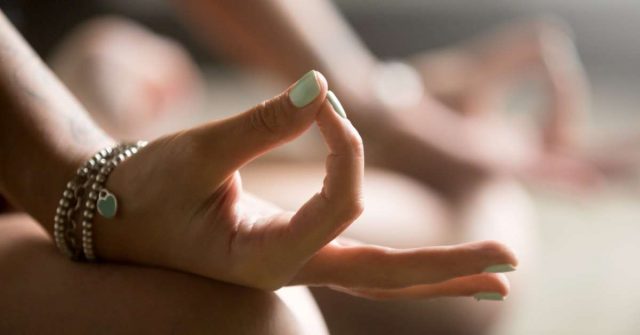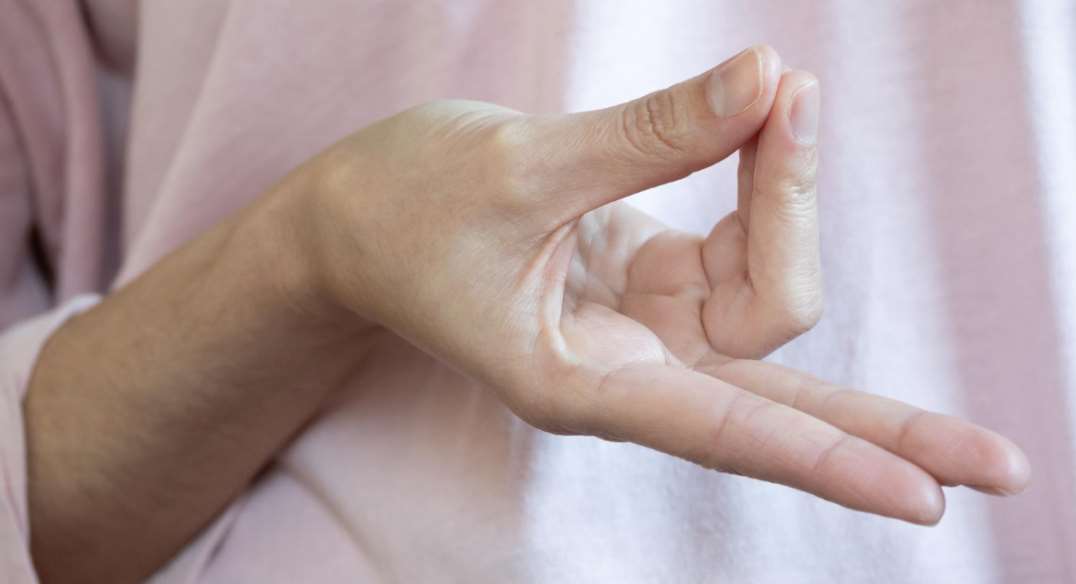If we consider the world we live in and the pace of life we go through each day is no wonder we constantly suffer from aches and pains in both our bodies and mind.
Aside from traditional medicine, pills, painkillers, or similar medications, people very often rely on yoga, meditation, or acupuncture. These are all fine and useful methods but there’s another more simple method that many Westerners haven’t even heard of.
We’re talking about Hand Mudra – Hand Gestures, a method that originates from India. The method stimulates various parts of the body and mind while relieving different kinds of pain and ache.
The method consists of ten basic hand gestures or mudras.
Perhaps you’re a skeptic now, but once you see how powerful the gestures are you’ll use them regularly.
Try these 10 Hand Mudras – Hand Gesticulation And Let Us Know What You Think:
1. Prana Mudra For Balance In Your Life
Prana mudra is one of the most prominent Yoga mudras that can be very beneficial for everyone practicing it.
Prana means life in Hindi and it is one of the five energies needed for the balance in life. Prana is believed to be the most significant energy ( the varista or superior prana) and when you practice it, you can activate and recharge the needed energy in your life. It is a simple sacred hand gesture that helps with the energy flow in our bodies.
This Mudra involves 3 fingers:
- the thumb that represents Agni ( fire), or the power to transform
- the little finger that represents jala ( water) or fluidity
- the ring finger represents prithvi (earth) or stability
It clearly links these three elements. When they are joined, they are in a balanced state and remove the imbalance in our body called Vata Dosha
How To Practice Prana Mudra?
When you practice prana mudra, you should sit in a comfortable position and relax your mind, so doing some meditation may help you. Prana Mudra is best to be practiced in the morning or 1 hour after having a meal.
Join the three fingers with mild pressure while keeping the other two fingers relaxed, straight and firm. You should practice with both hands and keep them over your knees. While practicing, be careful about the breathing pattern and stay in the same position without moving.
You can couple it with some relaxing music or chants like Om Namaha Shivaya Chant, Rama Chant, Om chant, or chants that you prefer.
What Do You Need To Know About This Technique?
- It can be practiced by anyone, no matter the age, gender, health condition, and even in pregnancy
- It can be practiced 2 to 3 times every day and for 10 minutes in a session, or in just one session of 20 minutes to half an hour
- Its success depends on the calmness of your mind and relaxation of your body
- If you cannot meditate before practicing it, you can take several deep breaths and make sure your breathing is rhythmical
Benefits Of Prana Mudra
According to some antient Hindi scriptures, our body has some disease when our energy or prana level is low. This practice can increase the energy level, and the body automatically heals itself, and it will boost your immune system.
Moreover, regular practice will heal all the ailments you might have and include:
- Lowers the fatigue and anxiety
- Make you feel more patient and less irritable
- Lowers sugar, blood, and pressure levels
- It can improve your eyesight and it is ideal for any kind of eye problem
- It can reduce muscle spasms and acidity in your body
- It can help you with self-confidence and relax your mind
- It improves your focus and productivity in everyday tasks
- It can help you with insomnia if practiced with jnana mudra
Side effects:
If you practice it together with pranayama, you should wear loose-fitting clothes and be careful not to strain your lings.
Do not practice it if you have back problems or you are a breastfeeding mother.
If you practice it for a longer session than recommended, you can gain weight.
2. Vayu Mudra For Sciatica
Vayu Mudra is the third most important form of the five forms of life energy called Prana and in Sanskrit means Wind, it is the air element and it can help you with various psychological problems, sciatica, rheumatic arthritis, etc…
According to Ayurveda, our body is composed of forty-nine Vayus, out of which 5 are vital. This Mudra maintains the air influx and reflux by creating a balance within the Nadis and releasing all the air excess from the body.
It is also called a Mudra for stomach gas because it is very useful for relieving gas from the stomach.
How to practice Vayu Mudra?
This Mudra focused on two fingers: index and thumb finger, but all fingers are actually moved.
So, here are the steps needed for practicing it:
- Sit in a comfortable position, preferably a cross-legged position, place your hands on your knees with your palms pointing to the ceiling and keep your spine straight.
- Close your eyes.
- Take some deep breaths and concentrate on the breathing patterns,
- Make a gentle pressure on the thumbs over the index fingers and keep the other 3 fingers straight.
- In the beginning, you might feel this gesture a little bit uneasy, but with time you will master it and you will feel at ease.
- When you complete the Mudra, release the fingers, open your eyes and you are finished.
You can practice this Mudra in 3 sessions of 15 minutes each when you have it practiced. In the beginning, you can start with 10 minutes per day and extend it to 45 minutes at a time. For having some benefits from it, you should practice it for 2 months.
It is recommended to be practiced early in the morning on an empty stomach, but this is not very strict as you can practice it at any time of the day. The best position for practicing is sitting and this will help you to focus on your hands and to reap all the benefits from it as follows:
- It is believed to reduce pain, especially the one related to sciatica, gout, and rheumatism
- It can help you with Parkinson’s disease and reduce tremors
- It is very helpful with gastric problems like bloating, excess gas, and flatulence.
- It can alleviate Neck pain, back pain and knee pain, spinal pain
- Help you with Paralysis
- It can help you with releasing toxins and acidity from your body
- Coupled with meditation and pranayama can help you with anxiety
This Mudra is very beneficial, and there are no known side effects from its practice. However, if you notice any side effects, it is recommended that you consult an expert.
You can refrain from practicing in case you:
- Have a flue or a cold
- If you have a stressful period
- If you have high blood pressure
- If you are exhausted and suffer from a lack of sleep
3. Abhaya Mudra For Divine Protection
This Mudra is a sacred seal and hand gesture that can be used when you are under stress or in challenging times to bring peace, safety, bravery, and divine protection.
If we translate its name from Sanskrit, it means ‘fearlessness’. The Hindu god Nataraja is usually depicted with his second right hand in this Mudra, giving divine protection and protecting all people who follow the righteous path of dharma from evil and ignorance.
It is believed that Buddha used this Mudra when he reached enlightenment, and it is linked to Gautama Buddha.
It is used as a gesture of good intentions and friendship when approaching strangers, and it is mostly used only with the right hand, showing that you are without a weapon.
How to practice it?
This Mudra can be used in different poses, such as
- Sukhasana (easy pose)
- Padmasana (lotus pose)
- or Virasana (hero pose)
- during meditation to overcome fears and bring protection and peace, so you can practice it to become your own protector.
When the left hand is used, it is related to Buddha when he ended a conflict between two families that we’re arguing about the irrigation of their land. So, when the left hand is raised, it means forbidding family relatives to fight.
When both hands are raised, this Mudra is called calming the ocean and refers to an event when Buddha stopped a flood in one village, which attracted many worshippers and followers.
Famous Buddha images in Abhaya mudra
One of the most famous Buddha images in Abhaya mudra is the standing image in the principal viharn of the Wat Chedi Luang in Chiang Mai.
There are some really admiring examples of “calming the ocean” Mudra, 20 meters tall standing Buddha at Khao Takiab hill in Hua Hin.
4. Dhyana Mudra For Profound Meditation
This Mudra is a hand gesture, and it is most commonly used during meditation to give you profound concertation.
In yoga, meditation is considered to be the most important and this requires deep concentration. The mind must be released from all distracting thoughts, and it is best to focus the mind and look at the midpoint of the eyebrow.
What does this Mudra mean in Sanskrit?
Sanskrit for “meditation, this mudra is the seventh Patanjali’s eight limbs of yoga.
Moreover, “Eclipse or Mind” stands for Dh and Yana, which stands for moving or going, so as the name suggests, it can completely cleanse the mind and lead you to positive thoughts.
The other term for this Mudra is Samadhi mudra and it is used in the representation of Śākyamuni Buddha and Amitābha Buddha.
How to practice Dhyana Mudra?
- In the beginning, sit in any comfortable position, with thighs on your knees and palms pointing to the ceiling.
- The back should be in a straight position, and if you cannot sit on the ground, you can sit on a chair.
- Close your eyes and take a few deep breaths before starting with the meditation.
- Your hands should be in your lap.
- Your palms should be facing upwards, and your right hand placed inside your left one. Both of your thumbs should make a triangle while the fingers are extended.
- Your hands should be placed on the level of your stomach and what is very important is you should be very careful about the rhythm of your breathing, which should be regular.
You can practice this Mudra for 10 minutes in 3 sessions daily or in one session of 35 minutes.
Benefits of Dhyana Mudra
- You will have positive thoughts and attainment of God
- Increase your power and divine knowledge
- It is the preliminary stage before samadhi (bliss or absorption)
- Awakens the energy in the body and improves the flow of life
- The shape of the triangle represents the three jewels of Buddhism- Buddha, Sangha (community), Dharma (teachings)
This Mudra is very good for students as it can improve their memory and you can practice regularly for 2 months.
This Mudra doesn’t have any side effects. But ensure that your thumbs do not put any pressure, which can lead to instability and restlessness.
5. Apana Mudra For Body Detoxification
Apana is the second most important of the five forms of Prana (life forces) in yoga and it is a Sanskrit word for wind. This mudra combines 2 mudras:
- Prithvi Mudra
- Akash Mudra
And joins 3 elements:
- fire
- space
- earth
The other term for Apana mudra is purification mudra and it is primarily used for purification and detoxication of the body. According to Ayurveda, the waste and the toxins accumulated in the body create an imbalance physically and mentally, so you can practice this Mudra to release all the accumulated toxins from the body.
It is an hasta mudra, which means it is done with the hands, and when this Mudra is practiced, the pelvic and abdominal areas responsible for the digestion are active, so functions of the digestive organs are improved and it is called a digestion mudra.
It controls the organs between the navel and perineum like the colon, the urinary system, reproductive system, and intestines.
How to practice it?
- Sit in a comfortable position and place your hands on your knees facing with palms upwards.
- Close your eyes.
- Take some deep breaths, bring your ring and middle fingers together, and bend them to touch your thumb.
- The other fingers should be extended and stay in that position for 15 minutes to half an hour. Focus on the energy flow in your body and divert your consciousness towards it.
- In the end, separate the fingers and open the eyes, relax and breathe easily.
- This Mudra can be done at any time of the day, in 3 sessions of 15 minutes or in one session of half an hour and it is best to be done on an empty stomach.
It can be practiced for six to eight weeks to reap all the benefits from it, such as:
- Boost immune system
- Improves the condition of your skin
- Helps with constipation and diarrhea
- Irregular period
- Impotence and man’s reproductive health
- Body detoxication
- Intestinal health
- Frequent urination
- Beneficial for migraines in combination with Jnana mudra
- Control the blood sugar levels ( followed by prana mudra)
- Fortifies the pelvic organs
Note: This Mudra shouldn’t be done during pregnancy, although it can be practiced during the 9th month to ease the childbirth.

6. Brahma Mudra For Neck Strengthening
This Mudra combines movement and sound and is a combination of two mudras:
1. Manas mudra (involves head movements)
2. Hasta mudra ( involves hands and fingers movements)
In Sanskrit, Brahma is the creator of the universe. The other name for this Mudra is Poorna mudra and with a meaning of a full breath.
The Hindu God Brahma had four heads, and they represent all-seeing, so when an individual practices this Mudra he moves the head in all directions while producing sounds which combined together make the sound of the universe, OM.
When practiced at a lower level, it will give you positive energy, while on a higher level, it is a path to universal knowledge to gain the supreme spirit, and in Sanskrit, the name Brahma means a supreme spirit.
How to do this Mudra?
The first step is taking a comfortable position and placing your hands on your knees with palms facing upwards.
The first component – the hand gesture
- Sit straight with a right position of the spine
- Close your eyes and take a few deep breaths
- Fold your thumbs inwards so they can touch the little fingers
- Wrap the other fingers over and around the thumbs and make fists
- The knuckles should face upwards and touch one another
- Keep them pressed and bring them close to your navel
The second component – exercise for neck strengthening
- Turn your head on the right slowly and exhale 4 to 6 seconds and make the sound aah on returning to the center
- Next, turn the head towards the left and when you return it back make the sound uuuh
- During the next inhalation, you should bend your head backward and, while slowly exhaling, make the sound eeeh when you return back to the center
- Bend your head down and slowly exhale, making the sound mmmh as you lift your head to the center
- Repeat this 3 to 12 times
Benefits of Apana Mudra
- It is a form of meditation and calms your body and mind
- Brings positive energy and releases the negative one
- Relieves the pain in the back and in the neck
- Relieves from anxiety and stress
- Stimulates the digestion
- Improves memory
- Improves focus and concentration at work
- You can reach a higher level of meditation
- It is best to be done on an empty stomach any time of the day. It is a great mudra to attain a higher meditative state

7. Mahasirs Mudra (Hand Gesture for Migraine)
This Mudra is great if you suffer from migraines, headaches, sinus pain, or regular eye strain.
- This hand gesture is very simple and let’s see how you can practice it to help you with migraines:
- Take a meditative position and relax your body by exhaling the inhale few times’
- Place your hands on your thighs, facing upward.
- Touch the tips of the thumb, index, and middle fingers together and point them upward
- Fold your ring finger, forming a ring towards the thumb’s base, while your little finger should be extended toward the ceiling.
- Inhale and exhale for about 6 minutes and relax
- You can practice it for 6 sessions during the day, and each should be 6 minutes at any time of the day for severe headaches
It is also very beneficial for:
- Stressed eyes
- Anxiety
- Sinus congestion
8. Linga Mudra For Lack Of Passion
This Mudra can help you to bring passion to your life and build the element of fire and increases your energy. It is called upright Mudra, and it looks like an erected phallus.
Linga Mudra in Sanskrit means hand gesture and represents the Supreme God Shiva, and it is associated with the male phallus and it is a symbol of masculinity.
When you keep your hands to make this Mudra, it can be very beneficial for your body physically and mentally.
If you have a cold or flu, you feel very energetic, and it is very beneficial for cough problems, cold or runny nose.
How to do Linga Mudra?
This Mudra can be done anytime and everywhere in just a few easy steps;
- Sit in a comfortable position and place your hands on your knees and thighs in an upward position
- Close your eyes and bring your hands in front of your body, clasp them and interlock the fingers.
- Keep your left thumb erected and encircle it with the right hand’s thumb and index finger.
- Focus on OM and the rhythmical breathing
- You can do it 10 minutes for 3 sessions daily or just one session of 35 minutes.
- Health benefits
- It is beneficial for weight loss
- To increase heat and energy in the body
- For treatment of cold and sinusitis, asthma
- Boost immune system
- For impotence and lack of passion
Note: You can avoid practicing it if you have menopause, thyroid disorders, ulcer, hypertension, migraine, or a recent stroke.
9. Udana Mudra For Respiratory And Thyroid Problems
This hand mudra is very beneficial for the respiratory system, thyroid, and speech problems. It is also called a laughter mudra and
This Mudra brings 4 elements together:
- The thumb represents the fire element
- The middle finger represents the space element
- The ring finger represents the earth element
- The index finger represents the air element
It is very easy to practice, and it can be done at any time of the day.
How to practice this Mudra?
- In the beginning, find a comfortable position and you can use a chair if you do not like sitting on the ground.
- Close your eyes and place your hands placing upwards on your knees or thighs
- Make a few breathings and be aware of the whole breathing process.
- Bend your index, ring, and middle over to touch your thumb, while the little finger should point straight,
- Stay in this position from 15 minutes to half an hour and feel all the changes that it brings to your body.
- In the end, open your eyes and relax your fingers
Health Benefits:
- Improves asthma and respiratory problems
- Voice and speech control
- Thyroid glands and thyroid problems
- The strength of the limbs
- Relived the depression and stress
- Pain and discomfort in the throat
You can practice this Mudra every day for a healthy throat, respiratory system, and relaxation.
10. Yoni Mudra For Female Reproductive System
This Mudra emulates the female reproductive system, and it is called a Shakti Mudra as it is related to the Hindu goddess Shakti. Every woman has endless possibilities as her womb gives life but also gives freedom, transformation, and expression. It is the best Mudra to strengthen the Sacral Chakra, which is important for reproductive organs and the feeling of creativity, feminism, creation, and growth.
This Mudra is for a woman who:
- Are under constant stress
- Cannot control their mind
- Cannot focus and concentrate on work
- Have hormonal and reproductive issues
How can you practice it?
Sit in a mediative position and keep the spine erect
- Place your thumbs on your ears, and the index fingers on your eyelashes, while the middle fingers on the nostrils
- The ring fingers should be placed above your lips, while the little fingers below them.
- Make yourself aware of the breathing and ensure that your elbows are at shoulder level.
- Touch both thumbs and join the tips of both index fingers, while both hands should face downwards and make a Namaste gesture
- Very slowly, start turning the ring, small and middle fingers inwards, and make sure the back of the fingers touch each other. Your hands will look like a womb.
- Press the tips of your thumbs while the tips of your index fingers are pointed toward your pelvis region.
- You can incorporate pranayama at this moment and close your eyes.
- Make attention to your breathing and breath fully. Practice this for 5 minutes 3 sessions per day.
When you practice it, you must lead a healthy lifestyle, and like any other yoga, posture is best to practice early in the morning.
Do not practice it if you are stressed or have a cold, or had some hand injury recently.

A professional writer with over a decade of incessant writing skills. Her topics of interest and expertise range from health, nutrition and psychology.






